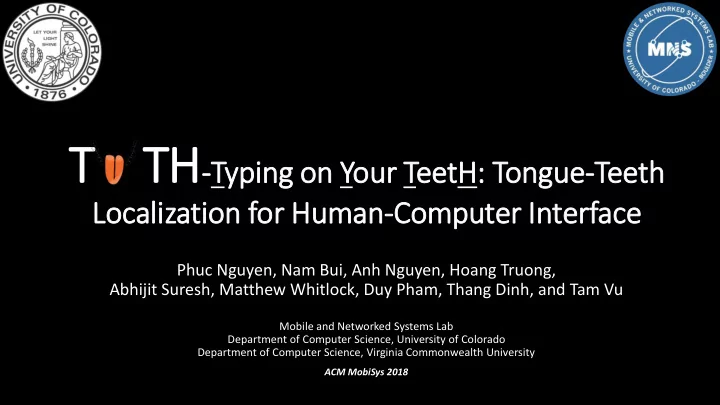

T T TH -Typing on Your TeetH: Tongue-Teeth Localization for Human-Computer In Interface Phuc Nguyen, Nam Bui, Anh Nguyen, Hoang Truong, Abhijit Suresh, Matthew Whitlock, Duy Pham, Thang Dinh, and Tam Vu Mobile and Networked Systems Lab Department of Computer Science, University of Colorado Department of Computer Science, Virginia Commonwealth University ACM MobiSys 2018
Upper Jaw 2 3 1 ABC DEF 4 6 5 GHI MNO JKL 7 8 9 PQRS TUV WXYZ 0 * # + Lower Jaw
It is challenging for ALS patients to interact with computing devices
Other Potential Usages A HAND-FREE INTERFACE FOR FACTORY WORKER TURNING MUSIC SHEETS FOR MUSICIANS HIDEN TEXT ENTRY INTERFACE CONTROLLING PHONE WHILE DRIVING USED IN TACTICAL SCENARIOS
• Non-invasive, • Continuous & long-term use, • Socially acceptable TYTH – Typing on Your TeetH
Experiment: Put your fingers at the back-of-the ear locations. Then, press any teeth using your tongue
Anatomical and Neurological Analysis of Tongue-Teeth Interaction Cortex Motor Cortex Sensorial Primary Motor Cortex
Brain sends commands out Cortex Motor Cortex Sensorial Primary Motor Cortex
Anatomical Analysis of Tongue-Teeth Movement Primary Motor Cortex EEG EEG EMG
Tongue is controlled by extrinsic and intrinsic muscles Styloglossus Dorsal surface of tongue Hyoglossus Mandible bone Genioglossus
TongueSee – CHI’14
It is difficult to make the device socially acceptable TongueSee – CHI’14
Tongue is controlled by extrinsic and intrinsic muscles Styloglossus Dorsal surface of tongue TYTH Hyoglossus Mandible bone Genioglossus Can we capture the tongue movement signal from this location?
Experimental Validation
Hardware Design
Sensing Techniques EEG EEG Sensing EEG EMG Sensing EMG SKD SKD Sensing
Sensing Techniques EEG Sensing EMG Sensing SKD Sensing
Sensing for EEG/EMG COTS Bio ioelectrical Sensing Cir ircuit • Programmable Gain • Programmable Filters • Low-Noise, 8 ADC Channel • 16kSample/s • uV sensitivity
Sensing Techniques EEG Sensing EMG Sensing SKD Sensing low amplitude low frequency signal
Skin Surface Deformation Sensing Technique Human skin Cooper (Gold plated) d Soft material (Silicon Dragon 0-10) Cooper tape (Gold plated) Capacitive sensing approach Permitivity Area size Capacitance Distance b/w 2 plates
Sensing Techniques EEG Sensing EMG Sensing SKD Sensing Challenge: These signals are extremely weak (mV/uV)
• Software Components to: • De-noising the signal • Extracting EEG, EMG from bio-electrical sensing data • Detecting when the tongue is typing/pressing • Classifying where the tongue is taping on • Recognizing untrained areas Challenge: These signals are extremely weak (mV/uV)
System Overview Key Electrical Sensor, Notch Filtering Tongue Feature Extraction Capacitive Sensor Mapping movement BP Filtering Detection Analog Amplifier Wavelet Feedback Low-rank SVM GMM Regression Model 60Hz Notch Filter Analysis Tongue Pressing Band Pass Filter Key EEG, EMG, SKD Classification Localization Detection Generation signals BLE Communication STFT Pre-processing Typing Detector Typing Recognizer TYTH wearable device Host Computer Host Device
Number of Gabor Low-Rank Analysis atoms in a dictionary • Every bio-signal f ( x ) can be represented as: atoms • Or, coefficient • Hence, Building dictionaries to extract the main structures of the signal. Please refer our paper for more details Each dictionary represents the key structure of each signal type (EEG, EMG)
Low-Rank Analysis f ( x ) f ( x EEG ) f ( x main structure ) f ( x EMG ) f ( x detail structure ) f ( x noise )
Pressing Detection • How do we detect when a user is tapping? Tongue movement Detection Wavelet • How do we detect when a user is Tongue pressing the teeth? Pressing Detection STFT Detecting the Tongue Movement by identifying the discontinuity of the signal. Detecting the Tongue Pressing based on the presence of the brain signal
Typing Area Classification: SVM - GMM MFCC features Initialization (UBM) Feature mean vector SVM delta Extraction Expectation double delta Maximization Linear GMM Cosine RBF Building a classification model to detect the trained typing areas
Typing Area Localization PCA 42 dimensions 3D space GMM output coordination During typing, typing location might not be exactly where it is trained. We build a Please refer our paper for more details regression model to detect the untrained areas to recognize these locations
Summary • Anatomical and Neurological Analysis • Hardware Sensing Design • Software Components Let’s put things together
TYTH’s Prototype
TYTH’s Prototype
TYTH’s Prototype EEG Sensors EMG Sensors SKD Sensors
TYTH’s Prototype
Performance Evaluation Teeth areas for evaluation
Typing Detection
Recognition Performance Classified Area Ground Truth Average Accuracy: 88.61%
User Study 1 – Extremely Difficult 2 – Difficult 3 – Normal 4 – Easy 5 – Extremely Easy % Ease to use TYTH
User Study Typing speed (s) What are the speed of typing on the teeth?
TYTH’s Sensing Techniques EEG Sensing EMG Sensing SKD Sensing
Conclusions • We introduce TYTH-Typing on Your TeetH, • A Non-invasive , • Continuous and Long-term use • and Socially Acceptable wearable device for Tongue-Teeth Localization Applications. • The key contributions include: • An analysis of brain, muscle, and skin deformation from behind the ears • An algorithm to extract the EEG, EMG signals • A novel method to sense a new type of signal, termed SKD signal • A ear-mounted wearable prototype • An evaluation of the system on 15 subjects
In progress • Miniaturization • Remove the impact of talking and body movement artifacts • Improve the form factor for better contact quality
Danke schön !!! T T TH -Typing on Your TeetH: Tongue-Teeth Localization for Human-Computer In Interface Phuc Nguyen, Nam Bui, Anh Nguyen, Hoang Truong, Abhijit Suresh, Matthew Whitlock, Duy Pham, Thang Dinh, and Tam Vu Mobile and Networked Systems Lab Department of Computer Science, University of Colorado Department of Computer Science, Virginia Commonwealth University ACM MobiSys 2018
Thank you
Related Works TongueSee – CHI’14 TongueWise –EMBC’10 Tongue-in-Cheek – CHI’15 SITA - UIST '12
Recommend
More recommend